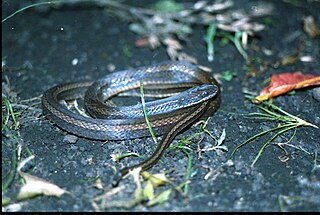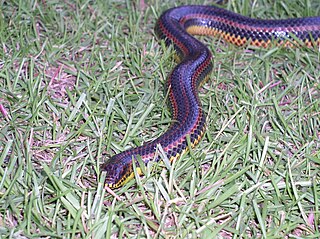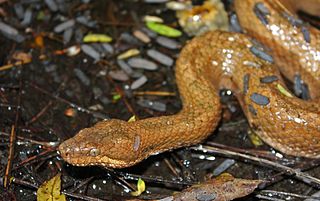
Colubridae is a family of snakes. With 249 genera, it is the largest snake family. The earliest species of the family date back to the Oligocene epoch. Colubrid snakes are found on every continent except Antarctica.

Boa is a genus of non-venomous boas found in Mexico, the Caribbean, and Central and South America. Five species are currently recognized.

Agkistrodon piscivorus is a species of pit viper in the subfamily Crotalinae of the family Viperidae. It is one of the world's few semiaquatic vipers, and is native to the southeastern United States. As an adult, it is large and capable of delivering a painful and potentially fatal bite. When threatened, it may respond by coiling its body and displaying its fangs. Individuals may bite when feeling threatened or being handled in any way. It tends to be found in or near water, particularly in slow-moving and shallow lakes, streams, and marshes. It is a capable swimmer and, like several species of snakes, is known to occasionally enter bays and estuaries and swim between barrier islands and the mainland.
The Crotalinae, commonly known as pit vipers, or pit adders, are a subfamily of vipers found in Eurasia and the Americas. Like all other vipers, they are venomous. They are distinguished by the presence of a heat-sensing pit organ located between the eye and the nostril on both sides of the head. Currently, 23 genera and 155 species are recognized: These are also the only viperids found in the Americas. The groups of snakes represented here include rattlesnakes, lanceheads, and Asian pit vipers. The type genus for this subfamily is Crotalus, of which the type species is the timber rattlesnake, C. horridus.

Coral snakes are a large group of elapid snakes that can be divided into two distinct groups, the Old World coral snakes and New World coral snakes. There are 16 species of Old World coral snakes, in three genera, and over 65 recognized species of New World coral snakes, in two genera. Genetic studies have found that the most basal lineages have origins in Asia, suggesting that the group originated in the Old World. While new world species of both genera are venomous, their bites are seldom lethal; only two confirmed fatalities have been documented in the past 100 years from the genus Micrurus. Meanwhile, snakes of the genus Micruroides have never caused a medically-significant bite.

The Leptotyphlopidae are a family of snakes found in North America, South America, Africa and Asia. All are fossorial and adapted to burrowing, feeding on ants and termites. Two subfamilies are recognized.

Liophis is a former genus of New World colubrid snakes. They have a wide range of nondescript and local names, among these "water snakes", "mapepires", "corals" or "racers".

Nerodia is a genus of nonvenomous colubrid snakes commonly referred to as water snakes due to their aquatic behavior. The genus includes nine species, all native to North America.

Coniophanes is a genus of colubrid snakes, commonly referred to as black-striped snakes, but they also have many other common names. The genus consists of 17 species, and despite the common name, not all of them display striping.

Farancia is a genus of colubrid snakes. It consists of two species, one commonly referred to as the rainbow snake and the other commonly referred to as the mud snake. Both species are native to the southeastern United States.

Leptodeira is a genus of colubrid snakes commonly referred to as cat-eyed snakes. The genus consists of 17 species that are native to primarily Mexico and Central America, but range as far north as the Rio Grande Valley region of Texas in United States and as far south as Argentina in South America.

Tropidophis, common name wood snakes or West Indian wood snakes, is a genus of dwarf boas endemic to the West Indies and South America. Currently, either 17 or 33 species are recognized, depending on the authority.

Tachymenis is a genus of venomous snakes belonging to the family Colubridae. Species in the genus Tachymenis are commonly known as slender snakes or short-tailed snakes and are primarily found in southern South America. Tachymenis are rear-fanged (opisthoglyphous) and are capable of producing a medically significant bite, with at least one species, T. peruviana, responsible for human fatalities.

Ninia is a genus of snakes, commonly referred to as coffee snakes, in the family Colubridae of the superfamily Colubroidea. The genus consists of 10 species that are native to Mexico, Central America, and the northern part of South America. Some species are also found on the Caribbean islands.

Senticolis is a genus of nonvenomous snake in the family Colubridae. The genus Senticolis is monotypic, containing the sole species Senticolis triaspis, also known as the green rat snake. The species is endemic to Central America, Mexico, southern Arizona, and southern New Mexico.

Atractus is a genus of colubrid ground snakes in the subfamily Dipsadinae. The genus includes more than 140 distinct species.

Robert Frederick Inger was an American herpetologist. During his lifetime, he wrote numerous books and publications about herpetology. He was also the curator for amphibians and reptiles at the Field Museum in Chicago, Illinois.

Dipsadinae is a large subfamily of colubroid snakes, sometimes referred to as a family (Dipsadidae). They are found in most of the Americas, including the West Indies, and are most diverse in South America. There are more than 700 species.

Apostolepis is a genus of snakes in the subfamily Dipsadinae. However, the familial placement differs among sources. It has also been placed in the family Colubridae, subfamily Dipsadinae or Xenodontinae, or in the family Xenodontidae. The genus Apostolepis is endemic to South America.

The common green racer is a species of venomous snake of the family Colubridae.



















